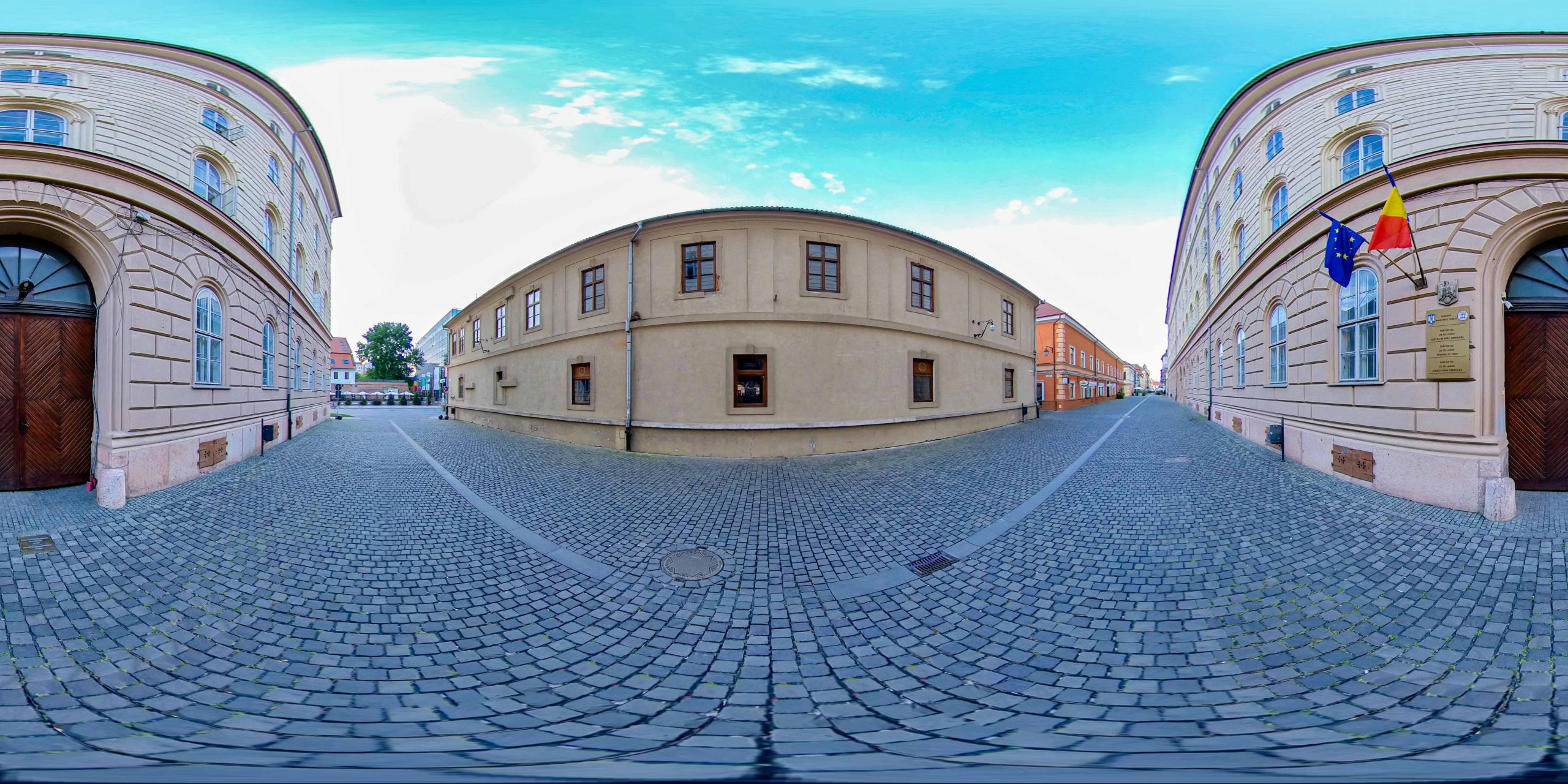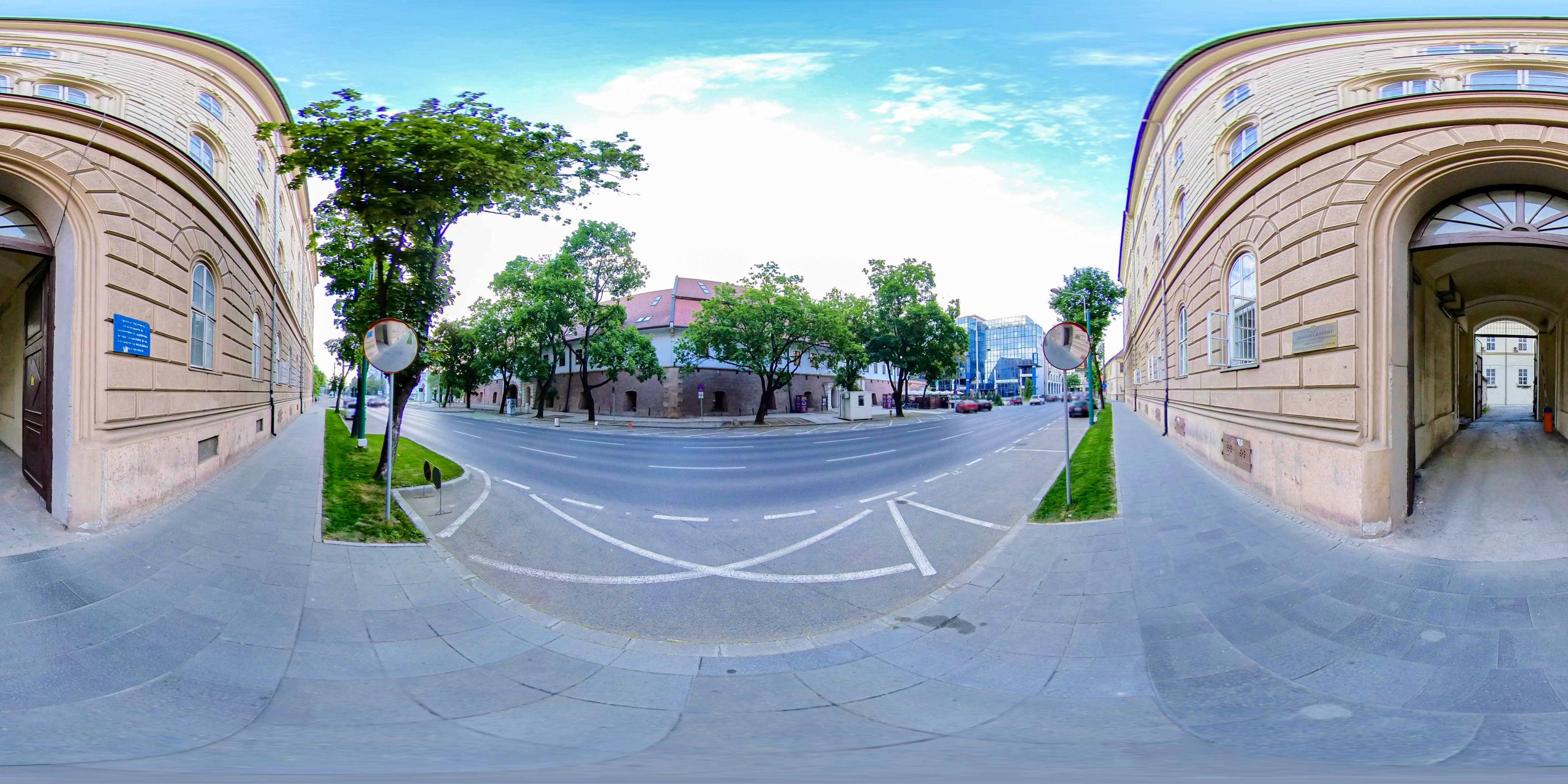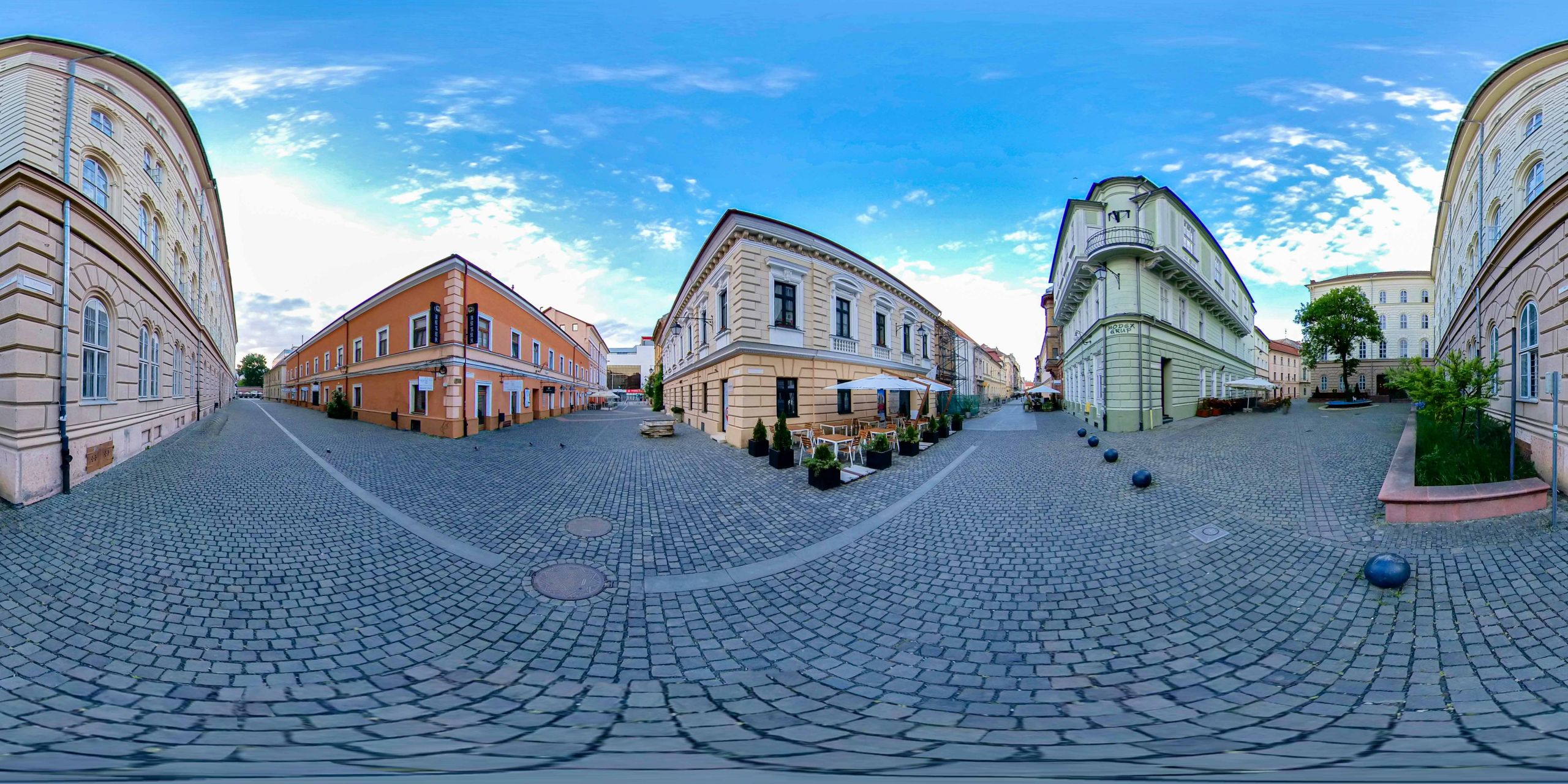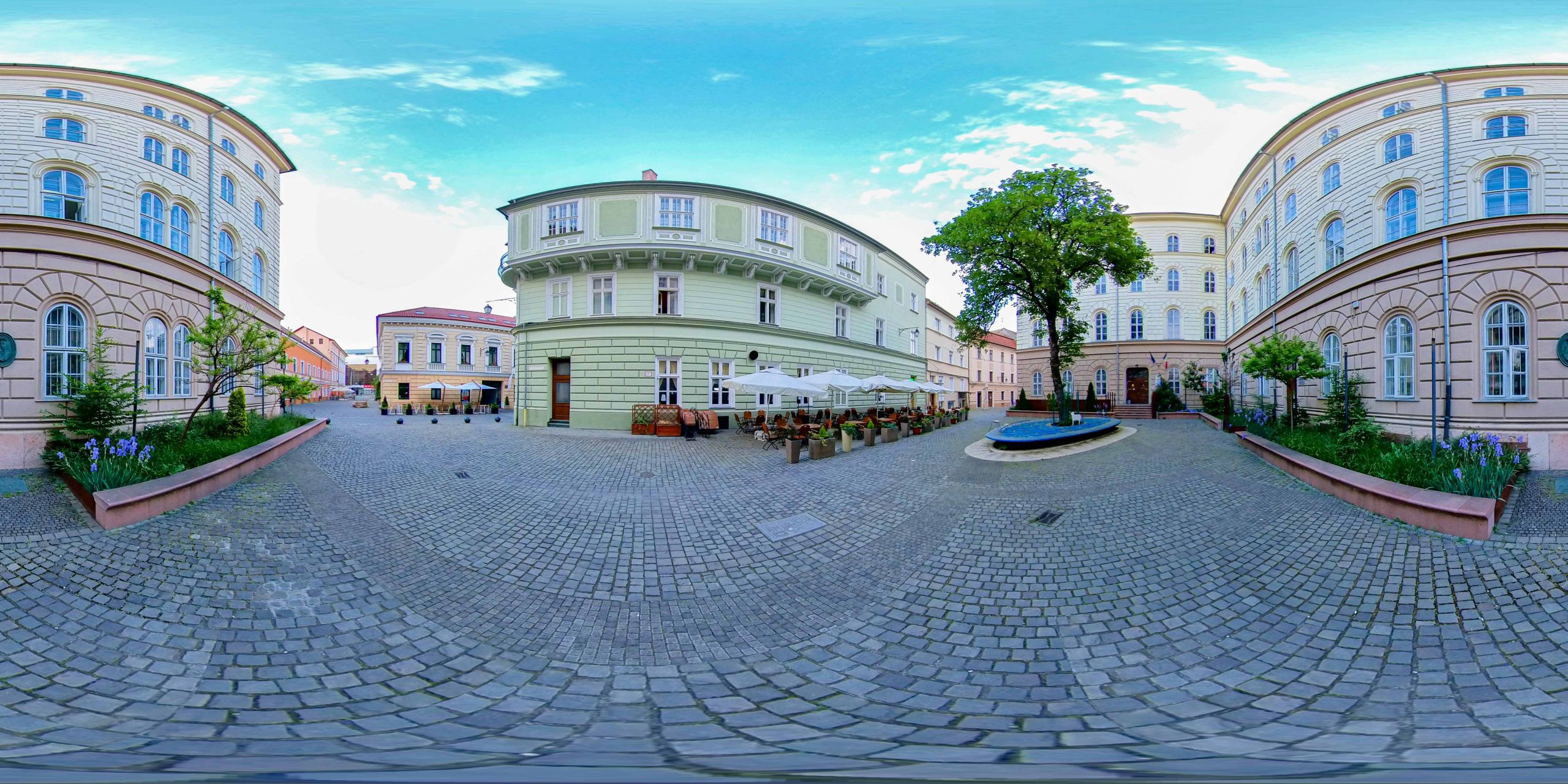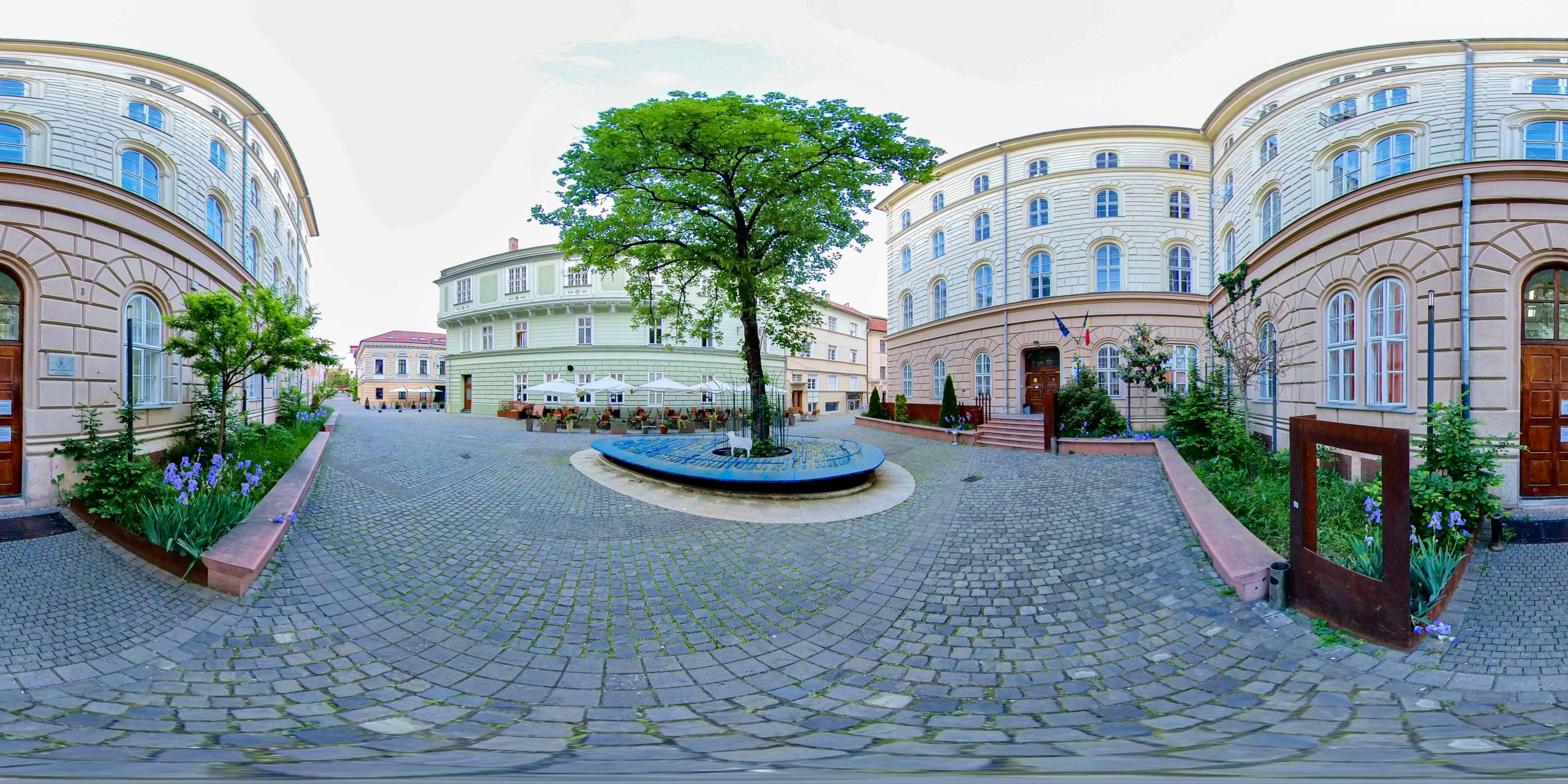The Dicasterial Palace was to serve as the seat of the crown government of the Serbian Voivodeship and the Banat of Timisoara, which was established after the revolution of 1848-1849 and had Timisoara as its capital.
Listen to the audio version.
The current building Episcopal Palace was built by the Austrian authorities in 1723. Although it seems that it was intended from the beginning to function as an episcopal palace, the building housed other institutions for a long time. In 1780, part of the building was donated to the Episcopate, and the other part to the Cathedral Chapter, an ancient episcopal office consisting of high-ranking clerics, who assisted the bishop in leading the diocese. In 1889, during the reign of Bishop Alexander Dessewffy of Csernek et Tarkeő, a major overhaul took place, which cost 420,000 florins. This is how the building got its current appearance. In 1891, on September 16, while visiting Timisoara, Emperor Franz Josef I was hosted in this building. Until the summer of 1950, an episcopal chapel with a wooden altar was kept upstairs, as Bishop Joseph Lonovics of Krivina received it as a gift from the Austrian Chancellor Klemens von Metternich. In 1950, the building was confiscated, and the chapel, the other rooms, the library, and the archive were severely damaged or even fully destroyed. The episcopal palace was restored in 1951, by the court decision, but it was abolished and reduced to the rank of a deanery by the communists. During that period, the building housed apartments distributed to various people, the ones loyal to the communist regime were upstairs, and on the ground floor, there were various shops. During the years 1994-1996, the building was subjected to an extensive process of restoration and renovation, trying to restore it, in the most faithful conditions, to the stage before 1950. With the completion of this restoration, the halls, administrative offices, apartments, the chapel, the library, and the archive found their place in the episcopal palace. On the ground floor, in a wing of the Palace, the Collection of religious art of the Roman Catholic Diocese of Timişoara was arranged.
Bibliography:
Ciprian Glăvan German-language press in Banat. 1771-1867, Argonaut Publishing House, Cluj-Napoca, 2015.
Mihai Opriș, Mihai Botescu, Historic architecture in TimișoaraPrinted by S.C. Tempus S.R.L, Timisoara, 2014, ISBN 978-973-1958-28-6.
The Dicasterial - Timisoara Court
Robert Șerban
loneliness
is the jeans pocket
where you never find anything
but for which you are glad
in silence
it’s not broken
June 2022
“He thought his city had a special destiny. From too much love, he would notice and amplify its little monstrosities. Deep down, he had long since started working on a movie based on Kafka’s novel. He started shooting at the Dicasterial Palace, with the facades depicted ‘in the severe style of the Early Florentine Renaissance’ (Mihai Opriș), but with sordid and gloomy interiors. […]
It was Sunday around noon. There seemed to be no one left in that part of the building. It was on the third floor. […]
He was typing his diploma paper. His uncle, then a clerk at the cooperative, had allowed it, with the approval of his superiors.
Suddenly, the security guard comes in without knocking. A beautiful perplexity set in on his face. Without a word, he grabbed him by the arm and pulled him along, politely but firmly. They went down corridor after corridor. Went down the stairs and then up to the attic. They were almost crawling. They stopped in front of a small door. Finally, the man opened his mouth: ‘Can you hear?’ and the bewilderment on his face took on a fuller hue. He could hear the clatter of dozens of typewriters, a highly appealing musical composition. The security guard pulled out a key. There was no one in the room. A few worn typewriters, barely visible in a messy pile of paperwork, lay right on the cement floor. ‘I’ve read this somewhere before’, he thought. Hardly had they pulled the door open when the rhythmic noise resumed. ‘I’ll stay for a while’, said the security guard with an almost painful smile, ‘I hope you’ll be fine without me’.” (Viorel Marineasa, The Dicastery, Târgu Mureș, Arhipelag Publishing House, 1995, pp. 117-118)
Viorel Marineasa Dicasterial (novel, fragment) Târgu Mureș, Arhipelag Publishing House, 1995.
He always wondered how a great artist like Orson Welles could miss the screening of the Trial so lamentablyEven the installation of the court in the building of a Parisian airport proved to be uninspired.
He thought his city had a special destiny. Loving the city way too much, he still noticed its little monstrosities, exaggerating them. In his mind, he already started screening a film based on Kafka's novel. He started filming at the Dicastery Palace, with the facades treated "in the severe style of the first Florentine Renaissance" (Mihai Opriş), but with sordid and gloomy interiors. As for the documentary, he had started it years ago, feeling it on his own skin.
It was Sunday around noon. There seemed to be no one in that building. He was on the third floor. He sat with his windows closed, protected from the dampness outside, whose pressure he still felt through insignificant blurred vision and breathing. The trickle of water in the sink came from the hallway. He didn't bother to check the faucet.
He was typing his bachelor's thesis. His uncle, then a co-operative, had allowed it, with the approval of his superiors. Suddenly, without any knock on door, the guard enters. A beautiful perplexity had settled on his face. Without any words, he grabbed his arm and pulled him closer, politely but firmly. They walked corridor after corridor together. They went downstairs, then up to the attic. They were almost walking on their toes. They stopped in front of a short door. Finally, the man opened his mouth and asked : “Do you hear this?" and the bewilderment on his face was rounded to a hue. He could hear the “music” the typing machines would make inside. The guard took a key out of his pocket. There was nobody inside that room, just a few old and dusty typing machines, and he thought to himself “I've read this somewhere before.” They barely pulled the door open and the rhythmic noises resumed. The guard murmured with a hurtful smile: “I’ll stay here for a little while”, "I hope you can do it without me."
He easily reconstituted the way back. He arrived extremely fast at the office he had just left. A few giggles held him at the doorway for a moment. "Another sight," he thought. He shook his head, as if to gain confidence in the oddities of life, and pressed the doorknob to enter the room. Right on the table where he worked, the guard was making love to a stranger. "Damn it, they scattered all my papers." "I hope you will not tell your uncle. In fact, I am a duty officer and during my work hours I do what I think is right," the woman laughed shamelessly. She stared at her hairy thighs and they were still trembling.
He did his best not to pay attention to them, although they continued to provoke him with pathetic obscenities. Eventually, acting all upset, they took their belongings and left him alone.
Hours passed, of course, but time felt as if it was stuck at noon. While he was sleeping, he heard the first scream and couldn’t sleep anymore. When he woke up, the whole thing was churning and scarlet spots appeared on the walls. A colorless, stinky liquid gushed from the floor. He reached the ground floor in a heartbeat. In his booth, the guard, with astonishment in his eyes, was spinning a huge knife in his hands. At his feet, the woman he slept with, still trembling with spasms, was lying in a pool of blood.
The prosecutor appeared, in the same building erected a hundred and ten years ago to house an ephemeral government.
Testimony 1
"My father died in 1941, when I was six years old. His memory is very vague, but as long as it is preserved, it is still important. What I am saying now may seem oxymoronic: a vague but still vivid memory. There are, however, memory enclaves that are very well preserved. For example, when he surprisingly took me to court in the Dicasterial. The dicasterial has remained a fabulous building for me: every time I pass by, I remember that time. I was also a little afraid of those endless and somewhat obscure corridors, of that bustle of very mixed humanity. The streets around the Tribunal, in fact the streets of the Citadel, still have a special charm for me to this day. For example, Eugeniu de Savoya street, where my father was born, at number 7, the house that still exists today, Mercy street, Augustin Pacha street today, Griselini street, with the craftsmen's tree, in which everyone, when they became a journeyman, beat a nail in it, and it is still kept there to this day. There was also a street I was afraid of, I don't know why, a crooked street, the current Ţarcu street, that used to give me an obscure fear at that age.
Radu Ciobanu, b. 1935, interviewed by Simona Adam in 2002
Testimony 2
Behind these two buildings, there is the Dicasterial Palace, which was built between 1850 and 1854 to serve the administration. It is built in the style of the Italian Renaissance, inspired by the Palazzo Strozzi in Florence. It is said that this building has as many windows as there are days in a year, so we count 365 windows. This palace was originally intended for the government of Serbian Vojvodina and Banat Timişan. The word "dicasterial" comes from the Greek "dicasterion" and the Latin "dicasterium", which in antiquity meant "Court with jurors". The building still houses, for the most part, legal institutions.
Behind the Dicasterial Palace you can see the roof and towers of the Roman Catholic Dome.
Else Schuster b. 1925 interviewed by Adrian Onică Adrian Onică in 2001
Testimony 3
(…) What was the name of the grandfather's family?
It's about the family from the mother's side: Popa, the family was called Popa. My grandfather's name was Gheorghe Popa, and my grandmother's name was Elisabeta Popa. We, the children, my sister, Michaela, and I, used to call our grandfather Big Father, or Father, and my grandmother was addressed as Big Mother.
What profession did the grandfather have?
My grandfather was a clerk at the court, here at the Court of Timișoara; sure, he sometimes took me to that building of the Tribunal, to the Dicasterial Palace ... I remember that I was suddenly horrified by the walls, by the winding corridors, they were endless, quite dark ... In my imagination from that time, all the small details of that space labyrinthine, they exerted a kind of - , not only curiosity, attraction, but also a kind of sensation of strangeness and mystery, even some fear... I don't know, I didn't know where those mixed feelings came from…
Eugen Bunaru interviewed by Aurora Dumitrescu in Timișoara, 2004, Third European Archive, BCUT.
